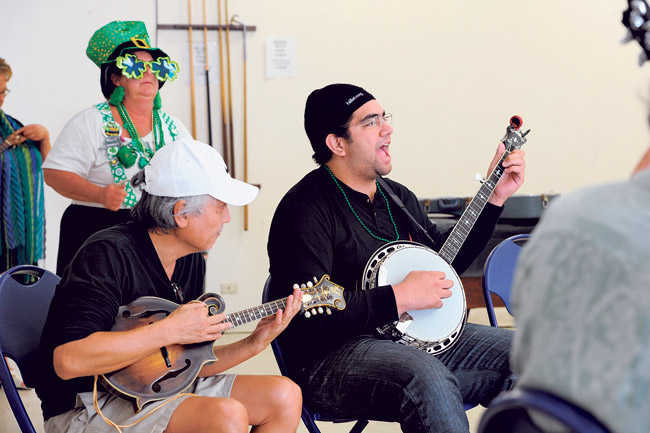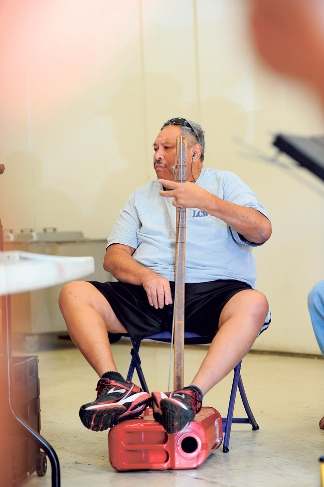Just Pickin’ and Grinnin’
When you think of bluegrass music, you invariably picture pine-tree-covered mountains in the background behind denim overall-attired folks with gaps in their teeth and a grass stalk kicked out between their lips.
But while its roots are firmly set in Appalachia, the appeal of bluegrass attracts folks from all walks of life – not because of what it is, but rather for what it is not.
feature_bluegrass_2
It is for musicians what San Francisco is for the nudist, Las Vegas for the gambler and New Orleans for the partier. It is a place where the rules of music are blurred and the constraints of conductors, chords and concerts are set aside so that musicians can do what is at their very core: Make the music that they want to hear.
Bluegrass artists do not perform, they jam. The audience may listen, but they are not there to be pleased, their enjoyment is just a byproduct of the artists’ primary goal to entertain themselves.
“They love the freedom that bluegrass affords them,” says Bluegrass Hawaii spokesman Mike Spengel of its musical members. “They don’t have to play the note that is on the paper, but rather do whatever they wanted with their violin. That is the attraction.”
Paper is actually discouraged in bluegrass circles. The music is an organic thing that lives and breathes, not something that can be summed up in stanzas. Putting the music down on paper dooms it, restraining its natural ability to change at the whim of the player.
Instead, bluegrass must be played by ear, with the notes coming as a response to not just the musicians around you, but the feelings that the song generates within one’s self.
The regimen of the song-writer’s intention takes a backseat to the joy derived by the players. The enjoyment of the many takes precedent over the tyranny of the one – democracy at its essence.
“The question isn’t if the tune is known note-by-note, but rather if the melody is known,” says Spengel, who only found bluegrass four years ago at the tender age of 69. “If a few of the others in the group are familiar with it, a key will be agreed to and the questioner will lead off while the others join in. Those who were originally unfamiliar with the tune soon pick up on it and join in, too.
“Each person in the group is given the opportunity to solo, if they wish. At the end of the tune, the next person in the circle chooses the next song to be played. The music is played almost exclusively by ear.”
The membership of Bluegrass Hawaii bears little resemblance to its hillbilly roots, with its collection of pilots, classically trained musicians and the Harvard Law graduate they have organizing this month’s Bluegrass in the Ko’olaus campout.
The conifer canopy of its humble beginnings will be replaced by the jurassic splendor of Ho’omaluhia Botanical Gardens in Kaneohe April 26-29. Keeping with its open format, the entire event is free and open to the public. You are welcome to come for an afternoon or spend the entire four days with them. All the details are available on their website, bluegrasshawaii.com.
They will provide complimentary lunches and potluck dinners throughout the festival. They only ask for those who can to make donations to help defray the costs and to provide side dishes, if you are able.
The first day is made up of alternating sessions of eating and jamming, where anyone with an instrument or a voice, regardless of talent level, is encouraged to join in.
“The ideal jam group is with about six people, but we usually have a dozen or more,” says Spengel, who notes that they always need more banjos and fiddles, but have a glut of the instrument of Spengel’s choice, guitar. “But at the campout we can all break away into little hives and jam in smaller groups.”
Saturday will open with a series of workshops to help neophytes hone their jamming skills. The classes, like everything else, are free and focus on guitar, mandolin, autoharp and fiddle. The only prerequisite is that you bring your own equipment – while the members are generous with their time, the same cannot be said of their instruments.
The afternoon will feature several local groups – including Discord and Rye, North Shore Ramblers, Bluegrass Barnstormers and Saloon Pilots – all giving their take on the genre. But perhaps the most popular event of them all is Sunday, when what little organization the group has is thrown to the wind – or, more accurately, into a hat.
Just after noon Sunday they have their Band Scramble, where everyone’s name gets thrown into a hat and the groups are then divided at random and given a half hour to rehearse a couple of songs before the competition.
“It is done to a lot of good-natured heckling and kibitzing, and a winner is selected, and we get a bigger crowd for that than anything else,” says Spengel, who openly admits to being one of the worst musicians in the group. “It is a real mix of talent levels, from classically trained musicians to ones who don’t know squat about music and just got their instruments three months ago, and they are all mixed together.”
While most of us in the Islands are not too familiar with the basics of bluegrass, it does contain some of the paniolo musical elements with which we have been raised.
“Bluegrass music hits on the spectrum somewhere between folk and country and western music,” says Spengel, who got into blue-grass after emphysema took away his ability to do his first love, scuba diving. “A misconception about blue-grass is that it appeals only to hillbilly-type people, and that is not really true.
“There are people from all over the country involved in it, and from professions that might be a little surprising.”
The music allows them to transform themselves. The classically trained violinist – the job title alone evokes pretension – becomes a fiddler, just another affable member whose sounds tend to invoke smiles rather than somber nods.
The bassist sets aside the most cumbersome of instruments to strum a washtub bass fiddle, a bare foot atop the aluminum basin as he or she alternates the sounds by changing the pressure on the broom handle to which the single string is attached.
Even the agnostics can set aside their beliefs to enjoy the provincial joys of the harmonies provided by the church music of the South.
“I find that the gospel music is some of the more attractive music in bluegrass,” says Spengel. “It is popular among the non-religious people as well because of the quality of the music, and it lends itself to harmony.”
All of this to be enjoyed with the Ko’olaus as a backdrop, and while some may find the juxtaposition of the Hawaiian background with these Appalachian sounds as discordant, when one looks a little deeper at the cultures, perhaps it is not.
Compare bluegrass with that most quintessential of Hawaiian pastimes, surfing. The only commonality that all surfers share is the wave, much like all bluegrass players only share the melody. What you do on that wave or melody is up to you, whatever the spirit moves you to do.







